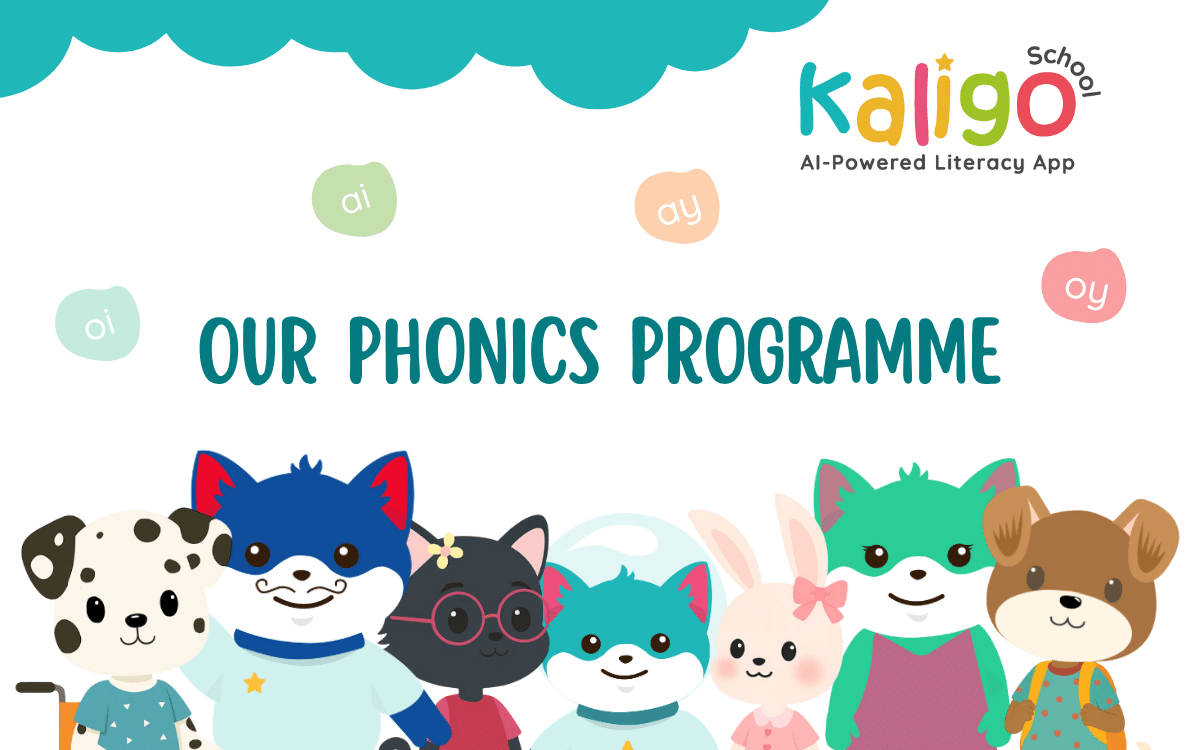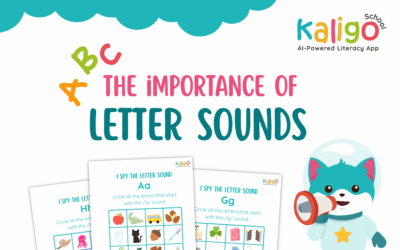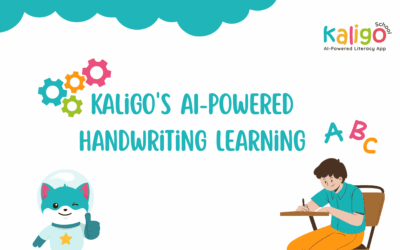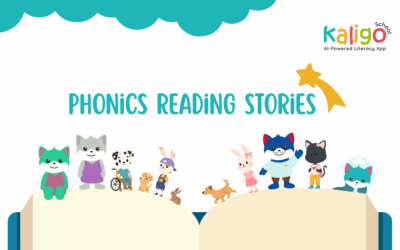Reading is foundational when it comes to developing children’s literacy competence. At Kaligo, we believe that teaching and learning reading can be achieved in a fun, engaging and scaffolded way. Thanks to our fully structured Kaligo Phonics Programme, children can become confident readers and writers. The Kaligo Phonics programme is a complete and interactive learning solution, ensuring a clear progression across 5 phases, from listening games to fluent reading.
What is the Kaligo Phonics Programme?
With over 550 ready-to-use lessons, the Kaligo Phonics Programme offers an extensive library of scaffolded and interactive content to build essential reading and writing skills step by step.
The 5 phases of the Kaligo Phonics Programme
To offer a clear and structured progression, our Phonics Programme reaches over 5 phases. This ensures that children move step by step from early listening skills to confident, independent reading and writing. Furthermore, the Kaligo Phonics Programme is fully aligned with the Letters and Sounds framework, giving educators confidence and structure in every lesson.
Each phase of the Kaligo Phonics Programme targets a specific set of skills:
- Phase 1: This phase targets listening and sound awareness. Phase 1 consists of 55 lessons designed for children in Nursery and Reception. During the first phase, children develop listening and speaking skills. They play with sounds, rhymes and rhythms. They also begin oral blending and segmenting. This phase builds phonemic awareness, the foundation of reading.
- Phase 2: This phase focuses on the first Grapheme-and-Phoneme correspondences. The 93 lessons of phase 2 introduce 19 letters and sounds to children in reception. The children start reading and spelling simple VC (vowel-consonant) and CVC (consonant-vowel-consonant) words. They also learn their first tricky words such as the, to, go or no.
- Phase 3: In this phase, aiming to train extending sounds and graphemes, 116 lessons help children in reception complete their alphabetic code. This includes digraphs and trigraphs (sh, ch, ai, igh…). Children gain fluency with CVC words, expand tricky words and practise their letter formation.
- Phase 4: Through 32 lessons, children in reception tackle consolidation and fluency. They strengthen their skills with longer words containing adjacent consonants (CVCC, CCVC, CCVCC) and begin reading and spelling two-syllable words.
- Phase 5: 291 lessons allow children in year 1 to learn different spellings for familiar sounds (for example /ai/ being spelt ai, ay or a-e). The children expand their vocabulary and master multi-syllable words.
A structured Phonics Programme that works
Starting from phase 2, each skill is structured around 4 scaffolded lessons:
- Revisit and Review: This initial lesson allows children to reactivate and consolidate prior knowledge, as well as strengthen retention before moving on to new content
- Discover a new GPC (Phase 2 and 3), Kalicat’s activities (Phase 4), Kalicat’s little adventures (Phase 5): This lesson introduces a new skill (new grapheme-phoneme correspondences, CVCC/CCVC/CCVCC words, etc.) through an engaging story in video format followed by comprehension or writing exercises, as well as listening and reading activities.
- Learn and practice: Children get the opportunity to work directly with the new skill through structured, scaffolded activities.
- Apply: Children learn to transfer and use the new skill in meaningful tasks, such as reading and building captions, forming sentences, writing, and spelling words
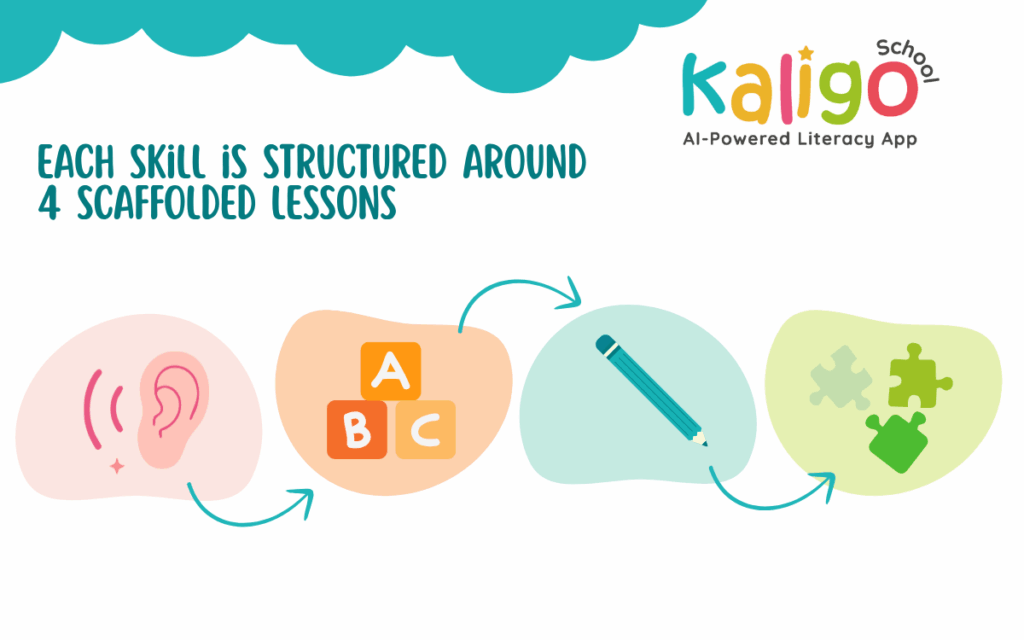
Mastering phonics through immersive stories
From phase 2 onwards, children will be able to follow the story of Kalicat and his friends. The stories are set in fun, child-friendly universes. Each story is enriched with illustrations, background music, and carefully chosen vocabulary aligned with the phonics progression.
For phases 2, 3 and 4:
- Children listen to stories while seeing the target words highlighted on screen,
- The dual input of audio and visuals strengthens decoding skills, word recognition and memory retention,
- The vocabulary matches the lesson’s theme, making practice contextual and meaningful.
For phase 5:
- The stories become fully written with illustrated texts, read aloud with narration,
- Children can follow the text independently or in group sessions,
- Stories are also available as printable PDFs (as ‘reading stories’), which are ideal for silent reading, guided oral reading or projection on interactive whiteboards.
Build reading skills through Kalicat’s adventures
Each reading story follows the engaging stories of Kalicat. Each text is carefully crafted to reinforce the sounds and tricky words taught in the lesson. The reading stories also provide meaningful, age-appropriate reading practice. They build confidence through accessible, decodable stories.
Some ideas for classroom applications of the reading stories:
- Silent reading: Individual practice sessions that build independent reading confidence
- Read-Aloud Sessions: Build fluency and expression through guided oral reading practice
- Interactive Whiteboard: Whole-class reading sessions that bring everyone together.
- Video Adventures: Animated story versions that bring Kalicat’s world to life, making phonics both practical and magical
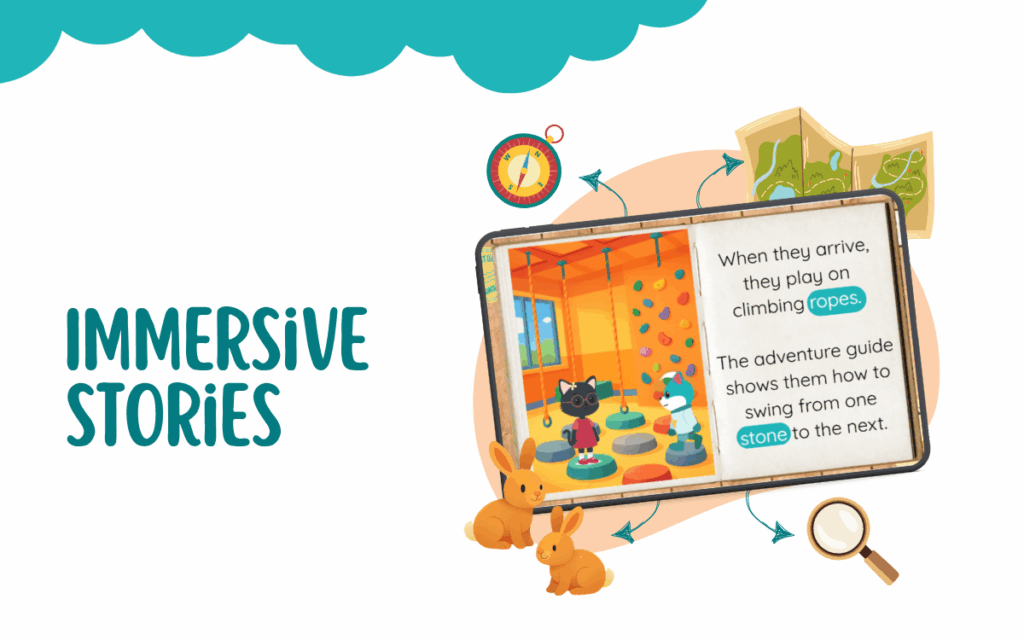
In every phase, each story is followed by comprehension questions, vocabulary questions and phonics exercises directly tied to the narrative. This creates a rich, contextual learning environment where practice feels natural and engaging. The connection between sounds words and meaning is strengthened, reading fluency and comprehension is boosted. Children stay motivated and immersed through Kalicat’s adventures. More details on our reading stories, as well as a free story to download, will be available soon, so stay tuned!
Beyond phonics: Social and Emotional Learning
Within our Kaligo Phonics Programme, we have integrated Social and Emotional Learning (SEL) elements. Through Kalicat stories, such as Harry and Kalicat Like to Help or Kalicat Says He Is Sorry, students not only develop literacy skills but also learn important values like empathy, cooperation, and self-awareness.
Free Phonics Resources For Teachers to Download
Each phase of the Kaligo Phonics Programme also features a vast set of teaching resources. Be it pedagogical guides, playful games or stories, every resource is designed to help educators and children master phonics in a fun and engaging way.
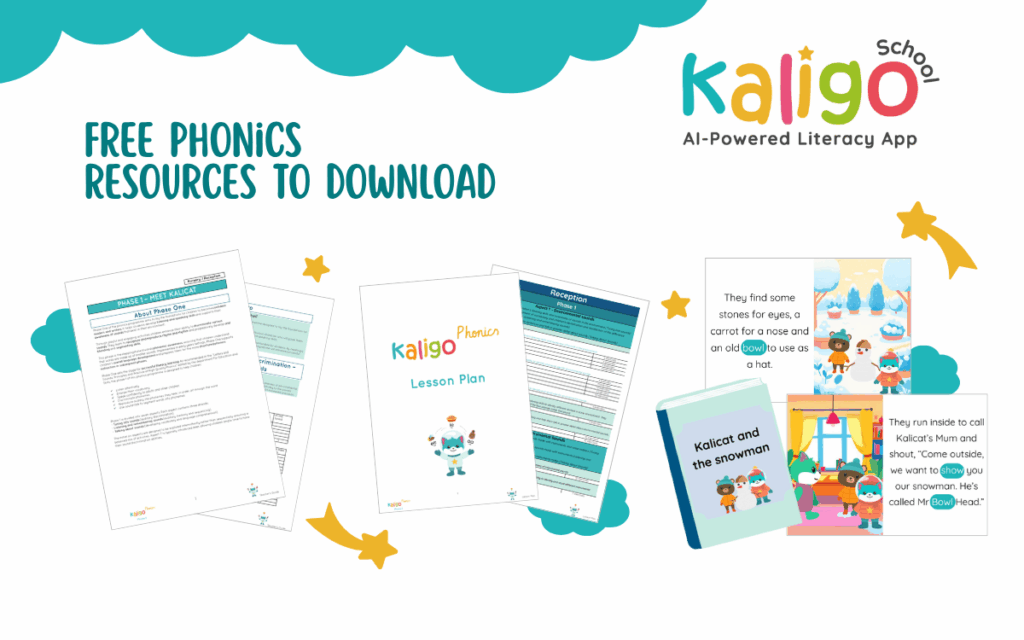
Free phonics resources to download for each phase:
- Phase 1: Playful listening and rhythm activities encourage children to recognize every day and musical sounds while exploring rhythm in playful ways. They also build rhythm, coordination, and musical awareness through interactive games and printable percussion cards.
- Phase 1 to 5: Lesson plans provide an overview of every lesson with clear learning objectives and outcomes. Perfect for quick reference and daily planning.
- Phase 2 to 5: Teacher guides which explain each activity step by step, list the target words, and provides helpful tips and teaching strategies to make lessons engaging and effective.
- Phase 5: Children discover engaging reading stories which follow the little adventures of our mascot Kalicat.
Why Choose the Kaligo Phonics Programme?
Choosing the Kaligo Phonics Programme allows children and educators to work with a complete library of scaffolded, interactive lessons to build essential reading and writing skills step by step.
The Kaligo Phonics Programme is:
- DfE-aligned: Fully aligned with the Letters and Sounds framework, giving teachers confidence and structure in every lesson.
- Tailored for Every Child: Assign lessons and adapt content to each student’s needs, ensuring personalised 1:1 instruction.
- An Array of Built-in Assessment Tools: Track student progress and identify areas for improvement with ready-to-use evaluation resources.
- Phonics with Handwriting Practice : Alongside interactive and playful exercises, children also practise spelling and word construction by writing by hand, strengthening sound–letter connections, memory, and fluency.
- Engaging and Motivating: Keep children excited with a wide variety of playful, interactive exercises featuring our mascot Kalicat.
The Kaligo Phonics Programme offers a comprehensive, engaging, and structured approach to teaching reading and writing. With its fully aligned curriculum, interactive lessons, and rich storytelling featuring Kalicat, children build strong literacy skills while enjoying the learning journey. By combining phonics instruction with emotional development and classroom flexibility, Kaligo empowers both educators and learners to achieve lasting reading success. The Kaligo Phonics Programme also supports you in preparing your year 1 Phonics Screening Check.
Ready to Develop Literacy Outcomes with Kaligo?
You’d like further support in developing your phonics lessons within Kaligo? Our team is happy to help! Reach out to us either via our contact form or directly using our chat feature.
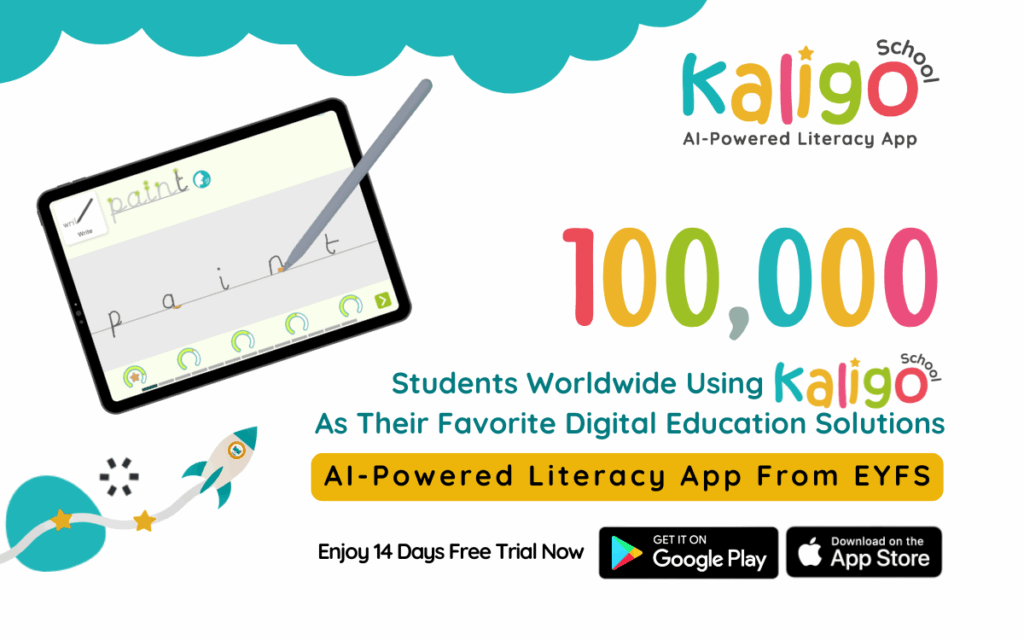
If you’re curious about using Kaligo, all it takes is a few clicks to get started. Fill out our trial form and try Kaligo completely for free for 14 days.
Start now with Kaligo and watch your class’ literacy skills improve, and your students learn with joy!

